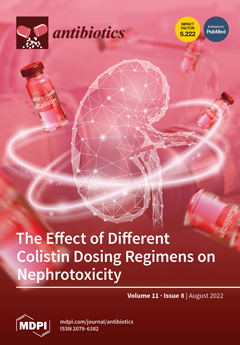Methionine aminopeptidases (MetAPs) are attractive drug targets due to their essential role in eukaryotes as well as prokaryotic cells. In this study, biochemical assays were performed on newly synthesized Isatin-pyrazole hydrazones (
PS1–14) to identify potent and selective bacterial MetAP
s inhibitors.
[...] Read more.
Methionine aminopeptidases (MetAPs) are attractive drug targets due to their essential role in eukaryotes as well as prokaryotic cells. In this study, biochemical assays were performed on newly synthesized Isatin-pyrazole hydrazones (
PS1–14) to identify potent and selective bacterial MetAP
s inhibitors. Compound
PS9 inhibited prokaryotic MetAP
s, i.e.,
MtMetAP1c,
EfMetAP1a and
SpMetAP1a with
Ki values of 0.31, 6.93 and 0.37 µM, respectively. Interestingly,
PS9 inhibited the human analogue
HsMetAP1b with
Ki (631.7 µM) about ten thousand-fold higher than the bacterial MetAPs. The in vitro screening against Gram-positive (
Enterococcus faecalis, Bacillus subtilis and
Staphylococcus aureus) and Gram-negative (
Pseudomonas aeruginosa, Klebsiella pneumonia and
Escherichia coli) bacterial strains also exhibited their antibacterial potential supported by minimum bactericidal concentration (MBC), disk diffusion assay, growth curve and time-kill curve experiments. Additionally,
PS6 and
PS9 had synergistic effects when combined with ampicillin (AMP) and ciprofloxacin (CIP) against selective bacterial strains.
PS9 showed no significant cytotoxic effect on human RBCs, HEK293 cells and
Galleria mellonella larvae in vivo.
PS9 inhibited the growth of multidrug-resistant environmental isolates as it showed the MIC lower than the standard drugs used against selective bacterial strains. Overall, the study suggested
PS9 could be a useful candidate for the development of antibacterial alternatives.
Full article






